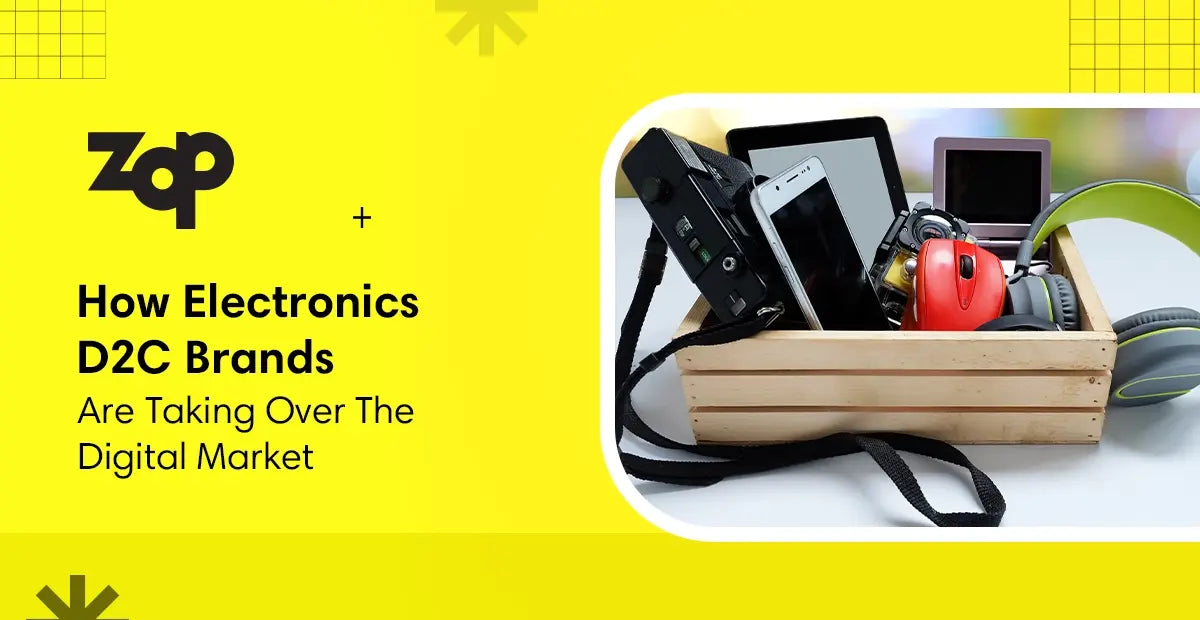The rise of direct-to-consumer (D2C) brands in the electronics sector transforms how consumers interact with technology. These electronics D2C brands bypass traditional retail channels, enabling them to connect with customers directly. Recent estimates suggested that the D2C market in India was projected to reach a remarkable USD 66 billion by 2023.
This shift has been fuelled by digital advancements, widespread internet access, and enhanced delivery logistics. Additionally, the increasingly tech-savvy millennials and Gen Z consumers are vital in driving demand for D2C electronics. Brands are now creating tailored experiences that resonate with these tech-savvy shoppers, allowing you to shop at your convenience.
This blog will explore how this trend reshapes the electronics industry, highlight notable D2C brands, and discuss some factors driving their success.
The D2C Model Explained
The Direct-to-Consumer (D2C) model allows brands to sell products directly to customers without intermediaries. This approach fosters closer relationships between brands and consumers, enabling companies to gather valuable insights and create tailored shopping experiences.
D2C brands focus heavily on digital channels, utilising eCommerce sites and social media to engage with their audience. Any industry can adopt the D2C model, as it allows brands to manage the entire lifecycle of their products. This includes production, sales, and distribution directly to consumers through their channels.
One significant feature of the D2C model is the increased control over the entire value chain. This level of control helps maintain a cohesive brand image and ensures a smooth customer experience. In contrast, traditional retail brands often depend on wholesalers or distributors, which can complicate management and dilute brand messaging.
Moreover, D2C electronic brands excel in communication with their customers. They utilise their websites, social media, and direct messaging to foster genuine connections. This direct interaction allows brands to grasp customer preferences and adapt their offerings accordingly. Traditional retailers, however, may struggle with this direct line of communication, often relying on third parties, which can hinder authentic engagement.
Factors Behind the Success of Electronics D2C Brands
Electronics D2C brands have reshaped the way products are marketed and sold. Several marketing factors have contributed to their success in the market, which are:
Cost-Effectiveness
One key reason for the growth of electronics D2C brands is their cost efficiency. Traditional retail models involve multiple intermediaries, each adding to the overall cost. In contrast, the D2C approach enables consumers to buy directly from brands, removing these extra layers. This simplification helps D2C electronics brands offer competitive prices while maintaining product quality, making them appealing to price-conscious customers.
Convenience of Online Shopping
The rise in online shopping has significantly benefited D2C brands. These brands can easily launch new products and make updates while closely monitoring customer experiences. They can quickly adapt to market changes without the logistical challenges of setting up physical stores. This online focus enhances customer convenience and allows brands to reach a wider audience.
Enhanced Engagement and Targeting
Social media plays a significant role in the success of D2C brands. Companies use platforms like Instagram and Facebook to showcase their products through engaging content such as reels and stories. This interactive approach not only spreads awareness but also fosters trust among consumers. D2C brands build strong relationships that contribute to long-term success by effectively communicating with their audience.
Growth in Information Technology
The booming information technology sector also supports the growth of D2C electronics brands. In 2023, global IT spending reached over USD 1.5 trillion, providing the tools and infrastructure necessary for these brands to thrive. The integration of advanced technologies enhances operational efficiency and enables better experiences, fueling the overall expansion of the electronics market.
Key Electronics D2C Brands in India
Internal Image Text: The Journey of Successful Electronics D2C Brands: Major Players in India
India is home to a rapidly growing electronics brand market that directly connects with consumers. Let’s explore some of the key electronics D2C brands in the Indian market.
boAt
boAt, launched by Aman Gupta and Sameer Mehta in 2016, offers a range of audio devices like headphones, earphones, and speakers. By focusing on affordability and marketing, boAt stood out in a market dominated by international brands.
The company positioned itself as more than just a product maker. They branded their buyers as “boAtheads,” creating a community of tech-savvy consumers. By doing this, boAt targeted younger audiences, presenting itself as a lifestyle brand. Their marketing efforts focused on connecting with consumers personally, contributing to their widespread popularity.
Noise
Noise began its journey by selling smartphone accessories but quickly expanded to smart wearables like earbuds and fitness trackers. Founded by Gaurav Khatri and Amit Khatri, the brand responded to rising health trends in India, offering devices that helped people monitor their fitness goals.
What sets Noise apart is its direct engagement with consumers. Despite not having external funding, Noise used social media platforms to communicate directly with customers. This approach and products offering regional language support and affordable pricing enabled them to break the competition.
HP
HP, a well-established global electronics brand, has made a strong mark in the Indian market. Known for its laptops and PCs, HP has focused on increasing its presence in India by aligning with local manufacturing initiatives like “Make in India.”
HP’s success is also driven by its ability to create recurring revenue streams. After capturing the market for laptops and printers, HP ensured continuous engagement by selling additional products like paper, ink, and maintenance services, which kept consumers coming back.
Fitbit
Fitbit, a leading player in the health wearables market, offers wireless devices that monitor and track health metrics. Fitbit doesn’t just sell fitness devices; it keeps users engaged with fitness challenges, games, and rewards, making exercise enjoyable rather than a chore.
Strategic partnerships and celebrity endorsements have further boosted Fitbit’s visibility. Fitbit's strong focus on fostering a connection with health-conscious consumers helped the brand grow significantly, encouraging users to stay loyal through exciting features and incentives.
Zebronics
Zebronics is another Indian brand making waves in the electronics space. Known for products like headphones, gaming accessories, and speakers, Zebronics delivers affordable yet high-quality technology. If you are looking for the best earbuds under 2000, Zebronics offers options that combine superior sound quality, comfort, and durability at an unbeatable price. The brand’s focus on innovation and reliability and its competitive pricing have made it a top choice among Indian consumers. By providing a variety of electronic devices that cater to different needs, Zebronics has positioned itself as a versatile and dependable brand in the Indian electronics market.
Strategies That Make Electronics D2C Brands Successful
Electronics D2C brands must adopt strategies to thrive in this competitive space, ensuring growth and customer satisfaction.
Balance Innovation with Quality
Maintaining a balance between innovation and product quality is crucial for electronics brands. Consumers expect electronics to be both reliable and advanced technology. To achieve this, brands must invest in research and development, ensuring their products meet evolving consumer demands while maintaining high-quality standards.
User-Friendly Website
For any D2C brand, a well-optimised website is essential. A website is usually the initial point of interaction between a brand and its likely customers. Making the site easy to navigate, with an easy checkout process and good product descriptions, can drastically improve sales and brand credibility.
Additionally, interactive elements like chatbots enhance the user experience, providing instant assistance and improving customer satisfaction.
Loyalty Programmes
One-time purchases aren’t enough to sustain growth. Electronics D2C brands must focus on retaining customers. Offering incentives such as discount coupons, free delivery, or loyalty rewards can keep customers returning for more.
Giving exclusive deals or early access to new products makes loyal customers feel valued, increasing their likelihood of repeat purchases. Rewarding loyalty helps build a dedicated customer base that supports sustained revenue growth.
Data-Driven Strategies
Successful brands use data analytics to make informed decisions. Gathering customer preference data allows brands to understand what products are in demand, helping avoid unnecessary production and saving resources.
Competitor analysis is another valuable strategy. By examining competitors’ strengths and weaknesses, brands can identify missed opportunities and make improvements.
Challenges Faced by D2C Electronics Brands
D2C electronics brands face unique challenges in the competitive online market. Here are some key obstacles they encounter in their journey:
Intense Competition and Product Differentiation
Electronics D2C brands struggle to stand out in an overcrowded marketplace. With countless online ventures offering similar products, showcasing a unique selling point (USP) is hard. Customers can easily compare features and prices across platforms, making it difficult for brands to differentiate their products.
Omnichannel Presence
Modern consumers expect brands to be available across multiple platforms. D2C electronics brands must ensure they are present wherever their target audience is, whether on social media, eCommerce platforms, or mobile apps. Being absent from a platform where competitors are active can mean lost opportunities.
High Advertising Costs
While advertising is essential for growth, it comes with a hefty price tag for D2C brands. Without a physical presence, they rely heavily on digital advertising to build brand awareness. However, running effective ad campaigns can be expensive, and not every D2C business has the budget to sustain it. This challenge makes it hard for smaller brands to compete with more established players.
Customer Acquisition and Retention
Attracting new customers and maintaining loyalty is a significant hurdle. Top D2C brands must work hard to build a connection with their customers. High acquisition costs and intense competition mean consumers can easily be swayed to try other brands. Establishing long-term loyalty takes time and consistent effort.
Unpredictable Consumer Demand
Consumer preferences in the electronics market can change quickly. One day, a product might be in high demand, and the next, consumers may shift their interest elsewhere. This unpredictability forces D2C brands to stay agile, but keeping up with fluctuating demands is no easy task.
Future of D2C Electronics Brands
The future of electronics D2C brands looks promising, marked by increased investment and growth potential. Experts anticipate a surge in funding as successful D2C companies demonstrate their ability to achieve solid returns. Investors are particularly interested in high-quality brands that focus on the efficient use of capital.
This interest is expected to drive significant mergers and acquisitions over the next few years as established companies look to acquire emerging D2C brands. The digital shift has empowered consumers, shifting the balance of power away from traditional retail and distribution channels.
eCommerce platforms like ZOP have simplified the shopping experience, making it easier for customers nationwide to find D2C brands. With the significantly reduced barriers to establishing physical retail outlets, D2C electronics brands can engage directly with their audiences without the overhead costs associated with brick-and-mortar stores.
Conclusion
The growth of electronics D2C brands represent a significant change in the consumer electronics market. These brands focus on the needs of their customers, implementing personalised strategies that enhance the shopping experience. By adopting omnichannel marketing techniques, they engage consumers across various platforms, ensuring a seamless experience. As a result, D2C brands are reshaping the landscape of electronics sales and redefining how customers connect with technology.












